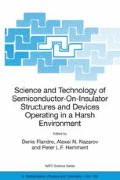Abstract
There are many advantages of using ultrathin fully depleted silicon on insulator (SOI) wafers in advanced integrated circuit technologies. This includes high-speed and low power circuit operation as well as reduced sensitivity to radiation effects that results from ideal isolation. These properties will make them especially useful for ULSI applications as the device dimensions are scaled to nanometer range. Perspective design of SOI MOSFET with improved characteristics and reliability in wide temperature range (4–600 K) could be realized in nanoscale.
Access this chapter
Tax calculation will be finalised at checkout
Purchases are for personal use only
Preview
Unable to display preview. Download preview PDF.
References
M. Bruel, A new silicon on insulator material technology, Electronic letters. 31(11), 1201–1205 (1995).
V. Lepilin, I. Mamichev, S. Prokofiev and V. Uritsky, MIS-transistor, A1 № 1355061 (1986). Official bulletin “Izobreteniya”. (6), 209 (1994) (Rus.).
V. Lepilin, I. Mamichev, S. Prokofiev and V. Uritsky, MIS-transistor, A1 № 1507145 (1986). Official bulletin “Izobreteniya”. (3), 208 (1994) (Rus.).
V.A. Gergel' and V. G. Mokerov, Significant improvement of the transistor transconductance and speed by using a graded channel, Russian Microelectronics. 30(4), 286–288 (2001).
E. Simoen, B. Diericks and C. Claeys, Analytical model for the kink effect in n-MOST's operating at liquid-helium temperatures, Solid State Electronics. 33(4), 445–454 (1990).
A. H. Johnston, Radiation effects in advanced microelectronics technologies, IEEE Transactions on nuclear science. 45(3), 1353 (1998).
J. P. Colinge, Trends in silicon on insulator technology, Microelectronic Engineering. 19, 795–802 (1992).
G. K. Celler and S. Cristoloveanu, Frontiers of silicon-on-insulator, J. Applied Physics. 93(9), 4955–4978 (2003).
Author information
Authors and Affiliations
Editor information
Editors and Affiliations
Rights and permissions
Copyright information
© 2005 Kluwer Academic Publishers
About this paper
Cite this paper
Uritsky, V.Y. (2005). Novel SOI MOSFET Structure for Operation over a Wide Range of Temperatures. In: Flandre, D., Nazarov, A.N., Hemment, P.L. (eds) Science and Technology of Semiconductor-On-Insulator Structures and Devices Operating in a Harsh Environment. NATO Science Series II: Mathematics, Physics and Chemistry, vol 185. Springer, Dordrecht. https://doi.org/10.1007/1-4020-3013-4_18
Download citation
DOI: https://doi.org/10.1007/1-4020-3013-4_18
Publisher Name: Springer, Dordrecht
Print ISBN: 978-1-4020-3011-6
Online ISBN: 978-1-4020-3013-0
eBook Packages: EngineeringEngineering (R0)

